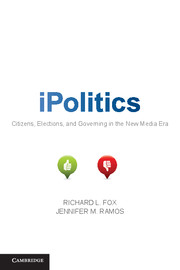Book contents
- Frontmatter
- Contents
- List of Tables and Figures
- Contributors
- Preface and Acknowledgments
- Introduction
- Section I The Shifting Media Universe and News Consumers
- Section II Campaigns and Elections in the New Media Environment
- 4 YouTube and TV Advertising Campaigns
- 5 The Rise of Web Campaigning in Finland
- 6 E-Campaigns in Old Europe
- Section III Civic Mobilization and Governance in the New Information Age
- Index
- References
4 - YouTube and TV Advertising Campaigns
Obama versus McCain in 2008
from Section II - Campaigns and Elections in the New Media Environment
Published online by Cambridge University Press: 05 June 2012
- Frontmatter
- Contents
- List of Tables and Figures
- Contributors
- Preface and Acknowledgments
- Introduction
- Section I The Shifting Media Universe and News Consumers
- Section II Campaigns and Elections in the New Media Environment
- 4 YouTube and TV Advertising Campaigns
- 5 The Rise of Web Campaigning in Finland
- 6 E-Campaigns in Old Europe
- Section III Civic Mobilization and Governance in the New Information Age
- Index
- References
Summary
The 2008 campaign marked the first time that a candidate's speech was set to music performed by popular musicians. Will.i.am, lead singer of the Black Eyed Peas, produced a YouTube music video of Barack Obama's “Yes We Can” speech. The “Yes We Can” video received more than 7 million views (January 2011), and Obama's words reached American youth in a way that had never been done. In short order, all of the candidates adopted the Internet as a platform for advertising, making 2008 the first YouTube presidential campaign. Candidates posted their television ads to YouTube as well as ads produced just for the new platform.
This is not the first time that candidates have adopted new technologies to reach voters. Historically, candidates have quickly embraced tools that expanded their access to voters – from Al Smith's first use of television to air an acceptance speech (1928), to Dwight Eisenhower's television ad campaign (1952), to Howard Dean's web-based credit card donation (2004). Now, YouTube, launched on February 14, 2005, has become one of the top three most-visited websites since at least 2008 (Alexa 2011). YouTube's popularity and its potential to reach voters were not lost on candidates.
- Type
- Chapter
- Information
- iPoliticsCitizens, Elections, and Governing in the New Media Era, pp. 103 - 124Publisher: Cambridge University PressPrint publication year: 2011
References
- 5
- Cited by

